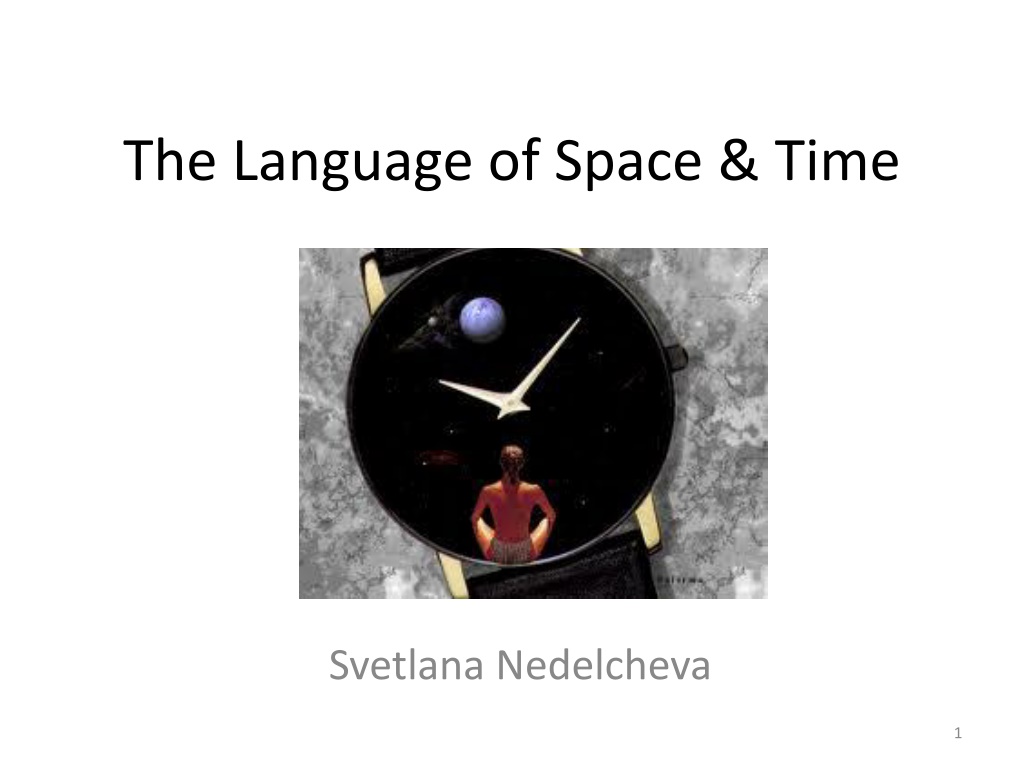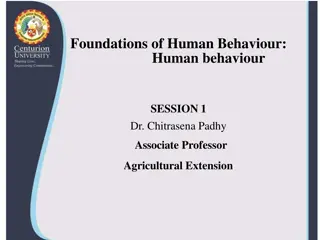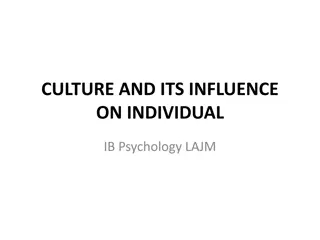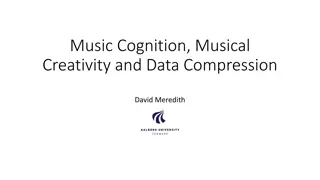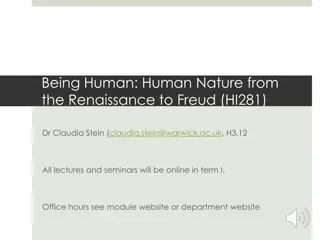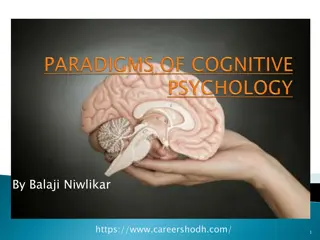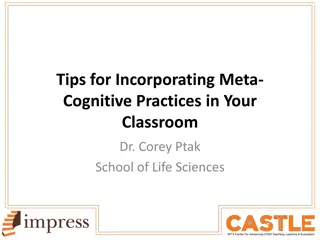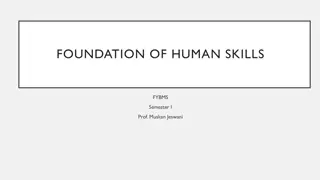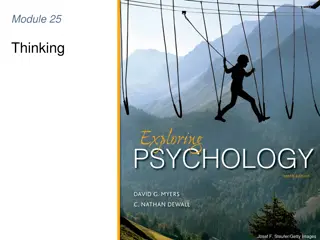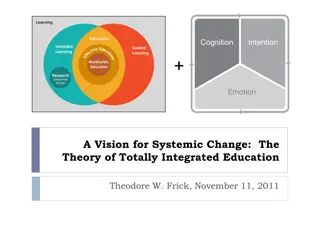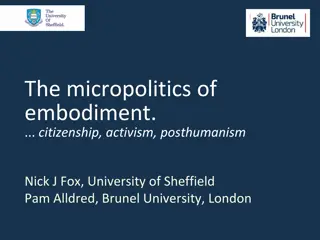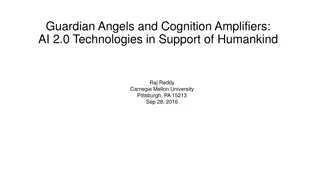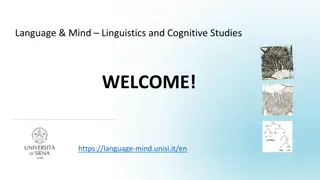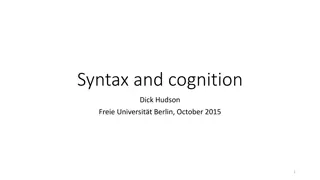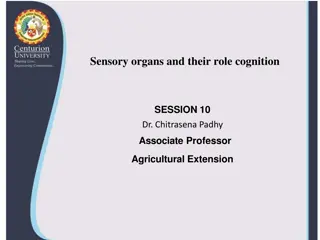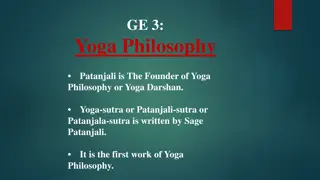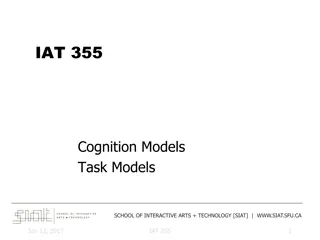Exploring the Embodied Nature of Human Cognition
Exploring the concept of embodied cognition, this content delves into how human perception and understanding are shaped by physical experiences and interactions with the world. From spatial scenes to the containment concept, it highlights the fundamental role of the body in shaping our cognitive processes.
Download Presentation

Please find below an Image/Link to download the presentation.
The content on the website is provided AS IS for your information and personal use only. It may not be sold, licensed, or shared on other websites without obtaining consent from the author. Download presentation by click this link. If you encounter any issues during the download, it is possible that the publisher has removed the file from their server.
E N D
Presentation Transcript
The Language of Space & Time Svetlana Nedelcheva 1
Embodied meaning and spatial experience
The real world provides the raw substrate for our sensory perceptions and the conceptualizations which arise from them. humanly perceived experience is fundamental to human cognition determined by the nature of the bodies we have => experience is embodied
Meaning itself is embodied (Evans, 2000; Heine, 1997: Jackendoff. 1983, 1990, 1992; Johnson, 1987; Lakoff, 1987; Langacker. 1987; Talmy, 2000, etc.) the concept of CONTAINMENT the surrounding LM will often offer physical protection from outside forces hide the TR from outside view
the spatial particle incodes the concept of CONTAINMENT I awoke in my bedroom I went to the cupboard in the kitchen I found the box of cereal in the cupboard I read it in the newspaper Anne Frank lived in perilous times Will is in love not limited to English
Spatial scenes we segment our perceptions of the world into spatial scenes these spatial scenes result from entities in the world - which exist independently of human beings perceived, then analysed and understood in ways which are wholly dependent upon the kind of neural architecture of the human brain, the particularities of the human body and the way these bodies interact with the world
My cup is on the table. contact functionally - support gravity prevents a cup from falling an understanding of the physical properties of the entities involved (e.g. size, materials they are made of, etc.)
the earliest formative experiences humans undergo battling with gravity to remain upright discovery of force dynamics (e.g. we can cause sth to move away from us when we push it and towards us when we pull it)
Polysemous lexemes, such as English spatial particles, form semantic polysemy networks Polysemy networks form as a result of speakers perceiving communicatively useful connections between a non- primary use and the primary sense.
OVER Its distinct senses did not just accidentally arise because, for instance, speakers could not think of another phonological string with which to label the distinct concept. Speakers must have found something in the basic spatio-physical configuration of over which connected to the concept of, say, 'completion' (e.g. The movie is over [=complete]).
Principled polysemy a particular formis conventionally associated with a number of distinct but related meanings not all contextually varying uses of a form constitute distinct senses the distinct senses constitute a semantic network in a systematic and motivated way
a spatial particle such as overhas a number of distinct meanings or senses associated with it there has been a tendency among some cognitive linguists, especially those working on lexical polysemy, to exaggerate the number distinct senses associated with a particular form
Methodology for determining distinct senses Tyler & Evans (2003) The reason - to minimize the subjective nature of our analysis First, a distinct sense must involve non-spatial meaning or a different configuration between the TR and LM than found in the proto-scene. Second, there must be instances of the sense that are context independent.
The helicopter hovered over the ocean. The bird hovered over the flower. TR over designates a spatial relation in which the TR is located higher than the LM the same basic TR-LM configuration holds in both and no additional non- spatial meaning is prompted for by one and not the other LM TR LM
Determining the primary sense - problems in terms of over, Lakoff (1987) following Brugman ([1981] 1988), argued that the primary sense for overis 'above and across', including a path, as in The plane flew over the city. Kreitzer (1997) disagreed, suggesting that the primary sense is something akin to an abovesense, as in The bird hovered over the flower.
Tyler and Evans (2003) - methodology to narrow the arbitrariness in the selection of a primary sense earliest attested meaning predominance in the semantic network relations to other spatial particles
One likely candidate for the primary sense is the HISTORICALLY EARLIEST SENSE. The earliest attested uses have to do with a spatial configuration holding between the TR and the LM. Predominance within a semantic network - the unique spatial configuration that is involved in the majority of the distinct senses found in the network.
Certain clusters of particles appear to form compositional sets that divide up various spatial dimensions. the particles above, over, underand belowappear to form a compositional set which divides the vertical dimension into 4 related subspaces upand down, beforeand after, and in front of and behind, and inand out
A spatial scene is an abstract representation of a recurring real-world spatio-physical configuration mediated by human conceptual processing. configurational element functional element
configurational element a trajector (TR), (i.e., the element located) and is typically smaller and movable; a landmark (LM), which is the element with respect to which the TR is located and is typically larger and immovable; and a conceptual spatial relation between the TR and the LM.
The infant is in her playpen. TR TR is the infant LM is the playpen conceptual spatial relation - in LM
functional element reflects the interactive relationship b/n the TR and the LM in a particular spatial configuration (Herskovits, 1986; Vandeloise, 1991, 1994) indesignates a relation in which the TR is enclosed by the LM - containment LM is three-dimensional in nature, and the TR is located within the bounded area of the LM
A proto-scene with more than one functional element The kids sat on the table the table supports the kids the table constrains the actions of the kids they place pressure on the table their bodies cover part of the table and that part is not visible
A proto-scene is an idealized mental representation across the recurring spatial scenes associated with a particular spatial particle. It is an abstraction across many similar spatial scenes. It combines idealized elements of real-world experience (objects called TRs and LMs) and a conceptual relation (a spatial configuration b/n the objects).
The cat is in the box. The convict is in his cell. TR - the shaded sphere LM - diagrammed by the dark lines the functional element of the configuration containment the vantage point for construing (i.e. viewing) the spatial scene is 'off-stage' (Langacker, 1987, 1991a) the conceptual spatial relation (in)
The notion of a vantage point suggests how a particular spatial scene is construed. The tablecloth is on the table. The cloth is over the table. The table is under the tablecloth. Certain parts of the spatial scene are profiled (see Langacker, 1987,1992).
Temporality / atemporality a spatial particle does not profile a relation which evolves through time represents a conceptualized relation holding between two entities (a TR and a LM) independent of sequential evolving profiles atemporal relations
Experiential correlation Joseph Grady (1997a, 1999) a consequence of the nature of interaction between humans and their environment is that certain kinds of experiences are frequently correlated (e.g. vertical elevation of a physical entity and an increase in the quantity of the entity)
The notion of two distinct experiences being correlated is an important one, as it leads to two distinct concepts becoming linked at the conceptual level. Prices have gone up recently. The stock market is rising. She's just got her highest test score of the semester. The population size is on the way up.
another example of experiential correlation -the experiences of knowing and seeing Seeing, sight and vision are conventionally interpreted as representing knowledge and understanding. I see what you mean. I see what you're trying to say. Now I see! [= understand] Your vision is just what our company needs.
IMAGE SCHEMAS FORM THE BASIS FOR ABSTRACT THOUGHT Lakoff (1987, 1990, 1993) and Johnson (1987) The birds are in love. . Ben is in trouble. . 31
Some more examples: The boss is in good mood today. The government is in a deep crisis. . She s coming out of the coma. I m slowly getting into shape. He fell into a depression. He is on duty. Val and his men were on alert. . . . . e . / . 32
State senses of English prepositions We are on alert/best behaviour/look-out/the run. state sense / - / / . state sense cf. We are on the bus. cf. . spatial sense spatial sense 33
State senses of English prepositions / / / state sense cf. . spatial sense We are at war/ variance/ dagger s drawn/ loggerheads state sense cf. We are at the bus stop. spatial sense (see Evans and Green 2006: chapter 10, for a review; see also Evans, Bergen and Zinken 2007) 34
ABSTRACT CONCEPTS our conceptual system organises abstract concepts in terms of more concrete kinds of experiences: motion, vertical elevation and physical proximity Christmas is fast approaching. The number of shares has gone up. Those two have a very close friendship. AFFECTION TIME QUANTITY 35
To sum up rigorous criteria for determining the primary sense of a spatial particle and for determining when an occurrence of a particle represents an independent sense in the network an interpretation created on-line for purposes of local understanding
However, even with these constraints, different speakers may have somewhat different intuitions concerning the precise relationship b/n the proto-scene and a particular 'extended' sense. Spatial scenes are complex and can be construed in many ways. The synchronic network reflects many aspects of its diachronic development.
